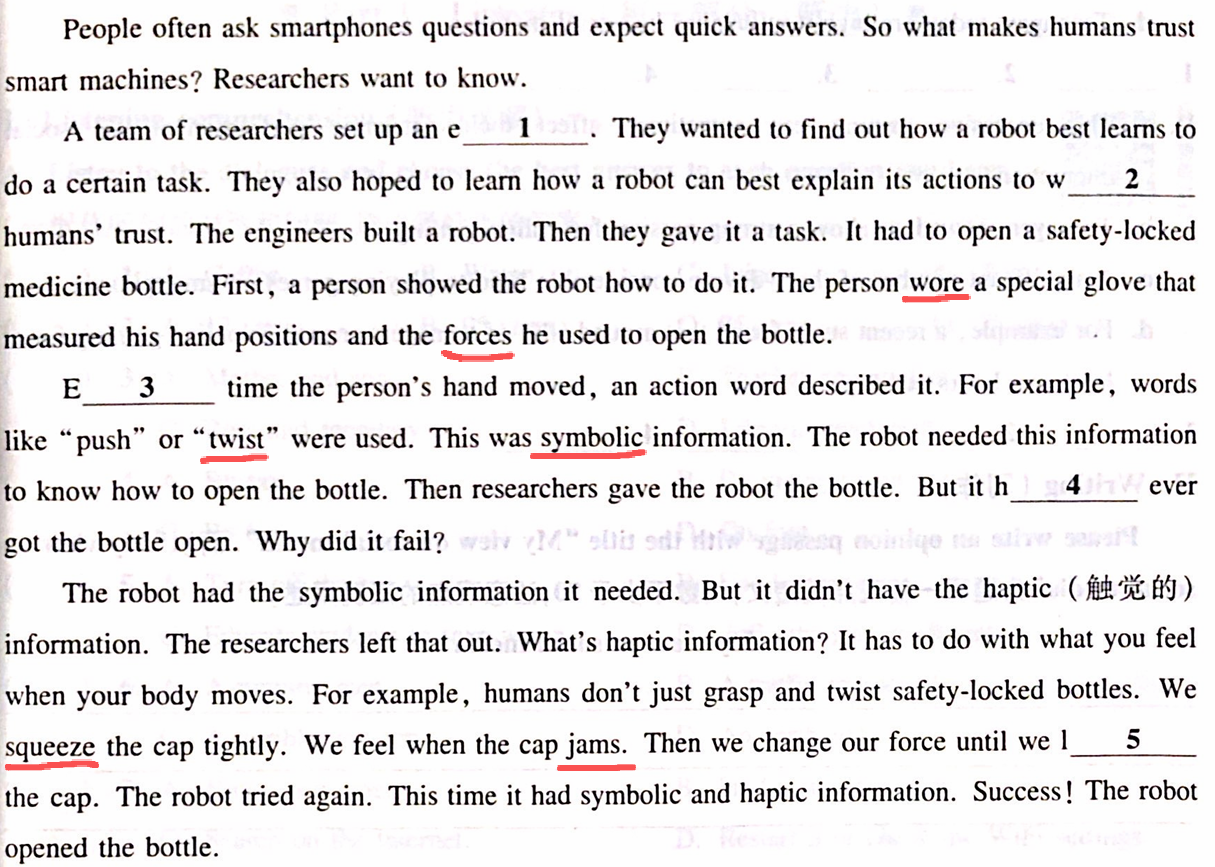

People often ask smartphones questions and expect quick answers.
人们经常向智能手机提问,并期望迅速得到答案。
So what makes humans trust smart machines? Researchers want to know.
那么,是什么让人类信任智能机器呢?研究人员想要找出答案。
A team of researchers set up an experiment.
一组研究人员设计了一个实验。
They wanted to find out how a robot best learns to do a certain task.
他们想了解机器人如何才能最好地学习完成某项任务。
They also hoped to learn how a robot can best explain its actions to win humans’ trust.
他们还希望了解,机器人如何才能最好地解释自己的行为,以赢得人类的信任。
The engineers built a robot. Then they gave it a task.
工程师们制造了一个机器人,然后给它布置了一项任务。
It had to open a safety-locked medicine bottle.
它需要打开一个带有安全锁的药瓶。
First, a person showed the robot how to do it.
首先,一位人类演示了如何完成这个任务。
The person wore a special glove that measured his hand positions and the forces he used to open the bottle.
这个人戴着一个特殊的手套,可以测量他打开瓶子时手的位置和所用的力。
Every time the person's hand moved, an action word described it.
每当这个人的手移动时,都会用一个动作词来描述这个动作。
For example, words like “push" or “twist" were used.
例如,会使用“推”或“扭转”这样的词。
This was symbolic information.
这就是符号信息。
The robot needed this information to know how to open the bottle.
机器人需要这些信息来学习如何打开瓶子。
Then researchers gave the robot the bottle.
然后,研究人员让机器人尝试打开瓶子。
But it hardly ever got the bottle open.
但它几乎没能打开瓶子。
Why did it fail?
它为什么失败了呢?
The robot had the symbolic information it needed.
机器人拥有所需的符号信息。
But it didn't have the haptic (触觉的) information.
但它没有触觉信息。
The researchers left that out.
研究人员故意省略了这一点。
What's haptic information?
什么是触觉信息?
It has to do with what you feel when your body moves.
它与身体移动时的感觉有关。
For example, humans don't just grasp and twist safety-locked bottles.
例如,人类在打开带安全锁的瓶子时,不只是抓住并旋转瓶盖。
We loosen the cap.
我们还会松动瓶盖。
The robot tried again.
机器人再次尝试。
This time it had symbolic and haptic information.
这次它同时拥有了符号信息和触觉信息。
Success! The robot opened the bottle.
成功了!机器人打开了瓶子。
An audience of 150 people watched the robot open the bottle.
150名观众观看了机器人打开瓶子的过程。
The audience was put into groups.
观众被分成了几个小组。
The robot gave each group a different explanation of the task.
机器人向每个小组提供了不同的任务解释。
One group was given both symbolic and haptic information.
一个小组得到了符号信息和触觉信息。
Some groups got only symbolic information.
有些小组只得到了符号信息。
Other groups got only haptic information.
另一些小组只得到了触觉信息。
And some groups got less information or none at all.
还有一些小组得到的信息较少,甚至什么信息都没有。
Which group trusted the robot the most?
哪个小组最信任机器人呢?
The group that received both the symbolic and haptic information.
是那个获得了符号信息和触觉信息的小组。
And they said the symbolic information helped them see the robot as trustworthy.
他们表示,符号信息让他们觉得机器人值得信任。
It was more important to them than the haptic information.
对他们来说,符号信息比触觉信息更重要。
==
People often ask smartphones questions and expect quick answers. So what makes humans trust smart machines? Researchers want to know.
A team of researchers set up an experiment. They wanted to find out how a robot best learns to do a certain task. They also hoped to learn how a robot can best explain its actions to win humans’ trust.
The engineers built a robot. Then they gave it a task. It had to open a safety-locked medicine bottle. First, a person showed the robot how to do it. The person wore a special glove that measured his hand positions and the forces he used to open the bottle.
Every time the person's hand moved, an action word described it. For example, words like “ push" or “twist" were used. This was symbolic information. The robot needed this information to know how to open the bottle. Then researchers gave the robot the bottle. But it hardly ever got the bottle open. Why did it fail?
The robot had the symbolic information it needed. But it didn't have the haptic (触觉的) information. The researchers left that out, What's haptic information? It has to do with what you feel when your body moves. For example, humans don't just grasp and twist safety-locked bottles.
We loosen the cap. The robot tried again. This time it had symbolic and haptic information. Success! The robot opened the bottle.
An audience of 150 people watched the robot open the bottle. The audience was put into groupsThe robot gave each group a different explanation of the task, One group was given both symbolic and haptic information. Some groups got only symbolic information. Other groups got only haptic information. And some groups got less information or none at all.
Which group trusted the robot the most? The group that recieved both the symbolic and hapticinformation. And they said the symbolic information helped them see the robot as trustworthy. It was more important to them than the haptic information.
